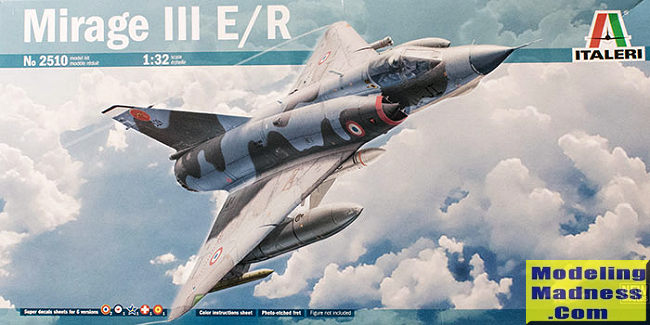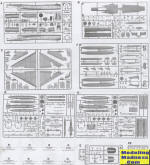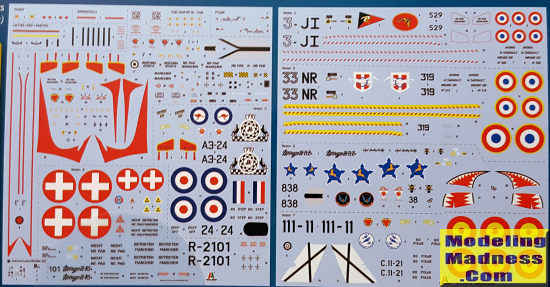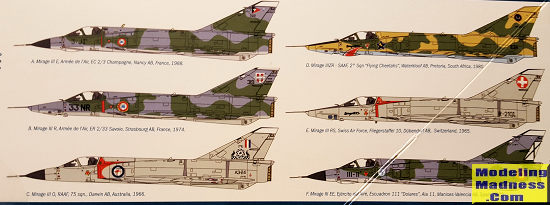
Italeri 1/32 Mirage IIIE/R
| KIT #: | 2510 |
| PRICE: | $149,00 SRP |
| DECALS: | Six Options |
| REVIEWER: | Tom Cleaver |
| NOTES: | 2017 release. Includes p.e. fret |

| HISTORY |
While the Mirage IIIC was being put into production, Dassault was also considering a multirole/strike variant of the aircraft, which eventually materialized as the Mirage IIIE. The first of three prototypes flew on 1 April 1961.
The Mirage IIIE differed from the IIIC interceptor most obviously in having a 30 cm (11.8 in) forward fuselage extension to increase the size of the avionics bay behind the cockpit. The stretch also helped increase fuel capacity, as the Mirage IIIC had marginal range and improvements were needed. The stretch was small and hard to notice, but the clue is that the bottom edge of the canopy on a Mirage IIIE ends directly above the top lip of the air intake, while on the IIIC it ends visibly back of the lip.
Many Mirage IIIE variants were also fitted with a Marconi continuous-wave Doppler navigation radar radome on the bottom of the fuselage, under the cockpit. However, while no IIICs had this feature, it was not universal on all variants of the IIIE. A similar inconsistent variation in Mirage fighter versions was the presence or absence of an HF antenna that was fitted as a forward extension to the vertical tailplane. On some Mirages, the leading edge of the tailplane was a straight line, while on those with the HF antenna the leading edge had a sloping extension forward. The extension appears to have been generally standard on production Mirage IIIAs and Mirage IIICs, but only appeared in some of the export versions of the Mirage IIIE.
The IIIE featured Thomson-CSF Cyrano II dual mode air / ground radar; a radar warning receiver (RWR) system with the antennas mounted in the vertical tailplane; and an Atar 09C engine, with a petal-style variable exhaust.
The first production Mirage IIIE was delivered to the AdA in January 1964, and a total of 192 were eventually delivered to that service.
Total production of the Mirage IIIE, including exports, was substantially larger than that of the Mirage IIIC, including exports, totaling 523 aircraft. In the mid-1960s one Mirage IIIE was fitted with the improved SNECMA Atar 09K-6 turbojet for trials, and given the confusing designation of Mirage IIIC2. The type was also modified be several nation with the addition of small canards on the upper intakes. This improved the turning capability of the aircraft.
| THE KIT |
 While I do not build many Mirages, I am a big fan of the type, particularly
the Mirage IIIE. I actually bought this kit as I wanted to do a Brazilian
version, but was disappointed to find out that Italeri did not include all the
bits I needed to do such. No problem as the kit provides six really great
markings options so it won't go to waste.
While I do not build many Mirages, I am a big fan of the type, particularly
the Mirage IIIE. I actually bought this kit as I wanted to do a Brazilian
version, but was disappointed to find out that Italeri did not include all the
bits I needed to do such. No problem as the kit provides six really great
markings options so it won't go to waste.
Once you get past the huge size of the box, you'll find an equally impressive instruction booklet that has 52 pages. True, not all those pages are build as a goodly number of them are taken up by the color and markings section, but it does give one a good idea of what is involved in this kit.
 It all starts
with the bang seat. This is is a ten piece construct with optional pull curtains
and part of the p.e. is used for the harness. I should mention that the photo
etch is rather minimal in this kit. It is basically for the aforementioned
harness, instrument panel, gun opening louvers, the little flat plate in between
intake and fuselage as well as attachments for the bits that fit inside the
canopy and windscreen. There is also a large frame that fits around the exhaust.
This would also be a good time to mention that you can model the kit without the
engine installed, but that leaves a gaping hole where you can look inside the
fuselage.
It all starts
with the bang seat. This is is a ten piece construct with optional pull curtains
and part of the p.e. is used for the harness. I should mention that the photo
etch is rather minimal in this kit. It is basically for the aforementioned
harness, instrument panel, gun opening louvers, the little flat plate in between
intake and fuselage as well as attachments for the bits that fit inside the
canopy and windscreen. There is also a large frame that fits around the exhaust.
This would also be a good time to mention that you can model the kit without the
engine installed, but that leaves a gaping hole where you can look inside the
fuselage.
Since you can do either the interceptor or the reconnaissance aircraft, there are differences in a number of areas. One is the differences in gun sights. You get the same instrument panel with both and there are decals to place atop some of the smaller panels and behind the photo etch face. The side consoles are part of the tub and have raised detailing that will require painting to enhance. There are sidewall sections to install as well. The Mirage III had a black interior so dry-brushing is pretty well a must for this,
A four piece nose gear well attaches to the back of the cockpit tub and this assembly as well as the inner main gear wells are attached to the lower fuselage piece. The kit provides full intake trunking that meets at the start of the first compressor stage of the engine. The engine is fairly nicely done and will be required for most modelers to install. This means you'll have to find places for nose weight, though the instructions are mum on just how much. The intakes will fit in between the upper fuselage halves along with the engine prior to installing the lower fuselage with the cockpit.
Wings are upper and lower halves and you'll have to decide what holes to open in the lower wing depending on the stuff you want to put on the plane. The instructions have you install the main gear legs at the same time as the main gear wells and from the way they are attached, you won't be able to put them on later. Speed brakes can be posed open or closed.
If doing the recce birds, you have several camera options as well as different camera windows. The lower nose section can be modeled open to show the cameras if you so desire. Flight controls are all separate items and you can model these lowered if you so wish. You can also model the gear doors closed, though I doubt many will choose this option. All the tires have flattened bottoms. Other optional bits on the underside are two different styles of doppler radar housing.
The canopy can be posed open or closed and a boarding ladder is included. There is also a nicely done engine stand for those who want to build the kit with the engine removed.
Pretty much all the 'things under wings' that were carried by the IIIE are included. On the centerline you can put a Matra AS 37 or R530. This will require trimming the small ventral housing. For tanks you have the 500, 1300, and 1700 liter versions included. Matra R550 Magic and AIM-9B Sidewinders are also included. The instructions include a load-out chart but do not mention which set-up is used by which markings option, which would have been helpful. There are also some pods that can be placed on the outer missile pylons.

The instructions are huge and provide the current CAD drawings we are getting to see more and more. All paint references are Italeri acrylics or FS 595. There are six markings options and two very large and colorful decal sheets are included. I've included a set of profiles for all the options so you can see what is included. There are also extensive data placement instructions for the airframe and weapons.

| CONCLUSIONS |
I would have to say that this pretty well supersedes the older Revell kit in this scale by quite a bit. It is great that it provides both standard interceptor and recce options. I'm sure the even now there are aftermarket bits being done for the kit if they are not already out there. The IIIE was used by so many nations that it would be a natural for at least additional decals. The way the kit is designed, it would not be unexpected for other variations to be kitted as well as the large number of Mirage V/5 variants. Well worth getting by the big plane builder and those who can deal with the rather high SRP.
| REFERENCES |
https://en.wikipedia.org/wiki/Dassault_Mirage_III
January 2018 Copyright
ModelingMadness.com. All rights reserved. If you would like your product reviewed fairly and fairly quickly, please contact the editor or see other details in the
Note to
Contributors. Back to the Main Page
Back to the Review
Index Page
Back to the Previews Index Page